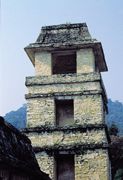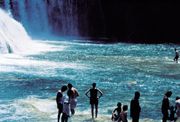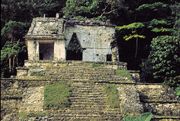
| Chiapas |
The natural wonders of Chiapas are impressive to even the most seasoned of travelers. It is blessed with beautiful lakes, thundering waterfalls, rain forest and pine covered mountains. The state retains colonial and precolonial structures, and is home to a multitude of indigenous groups speaking several Mayan dialects. Though conquered by the Spaniards 400 years ago, the Maya remain culturally distinct and still outnumber European descendants in much of their homeland.
Throughout the Yucatan Peninsula lie the ruins of hundreds of sites built by a civilization that began over 3,000 years ago. As a tribute to their gods the Maya built magnificent cities and ceremonial centers, many of which still remain.
Chiapas, rich in culture and natural beauty, welcomes tourists, most of whom come from Europe. Most North Americans have not yet discovered this part of the Mayan World which included what is now Belize, El Salvador, Guatemala, Honduras and the Mexican states of Campeche, Quintana Roo, Tabasco and Yucatan.
| |
| Tuxtla Gutierrez - Capital of the State. |
| |
| Sumidero Canyon - Awesome |
San Cristobal De Las Casas- Cool and RefreshingSan Cristobal is only a two-hour drive from Tuxtla, up a winding mountain road to an elevation of 7,200 feet. Spanish architecture with arches, flower gardens, narrow streets, tiled roofs and elaborate churches is a little misleading because the town is overwhelmingly Indian and that is the most important reason to visit San Cristobal.
This city is considered by many to be the most enchanting place in the state. Its colonial flavor is interwoven with the Mayan past providing an opportunity to see people whose clothing and customs date back hundreds of years. Each village uses its own colors and style in making their garments. Each culture is different with its own mysteries and traditions. The Indians reluctantly accept the inevitability of tourism but prefer the life they have.
Outside the Church of Santo Domingo, one can wander for hours, mesmerized by the quality and quantity of merchandise on display, at prices far below what they would be sold for anywhere else. Craftsmen from neighboring towns, even from Guatemala, use the area around the church to sell their wares. Diverse languages can be heard and though no one speaks English, everyone responds quickly to a smile. Point to what you like and the price is written in pesos. Bartering is expected.
Na Balom was the home of archaeologist Frans Blom and his wife Trudy who dedicated their lives to preserving the culture and rain forest of the Lacandon Indians. The home is now used as a museum/research center/library/ guest house. The extensive library of Mayan culture attracts social scientists from around the world. For information write: Na Balom, Av. Vicente Guerrero #33, San Cristobal de las Casas, Chiapas 29220.
| San Jaun Chamula |
Entering the church of St. John the Baptist was an experience I will never forget. The interior is candle lit and very dim. There are no pews or clergy. The floor is covered with pine needles and a sea of candles. Figures of saints line the walls, covered with colorful ribbons and mirrors suspended from their necks. The mirror symbolizes the sacred eye that sees with great clarity. The pagan rites of the Maya merge magically with the Catholic religion, diverging completely from the traditions of western Christianity.
Three musicians dressed in colorful ancient garb were playing guitars and a piano accordion while the community leader, the mayordomos prayed. Then they left, single-file, but most of the worshipers continued to pray devoutly, on their knees, sometimes stopping to take a drink of coke which is thought to cleanse the body when the person burps. The church is used mostly by shamans for cleansing and healing, using eggs, or sometimes a dead or a live chicken to pass over the sick person while performing the ritual.
A permit is required to enter the church. They are available at the Tourist Office for $1.50 Cdn.
Out on the square in front of the church, piles of beautiful woven wool shawls, garments and vests were stacked for sale. Little children swarmed around us, begging us to buy purses, little dolls and woven belts. The shawls sold for $6.00 Cdn. What a bargain!
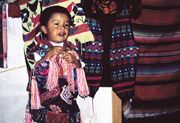
Zinancantan, a small community much like San Juan Chamula is only 8km/5mi away. A permit must be bought to enter the Church of San Lorenzo. Traditions, clothing and attitudes differ remarkably from the Chamulas. Though dedicated to their culture, they are more enterprising, their village is clean and everyone seems to work. We visited a weaver’s house where the extended family produces textiles and colorful embroidery. Their tablecloths, place mats, bedspreads and jackets make great gifts.
| Agua Azul |
The cascades of Agua Azul, 66 km south of Palenque, has more than 500 falls crashing into turquoise pools. Visitors are mesmerized by the beauty. The higher you climb, the more dazzling it becomes with rivers and brooks cutting across the green valley floor. Misol-Ha, another waterfall about 25 km from Palenque has a 35 meter-fall dropping into a beautiful wide pool, safe for swimming.
| Palenque |
The archaeological zone of Palenque is considered to be one of the most beautiful in Mexico. The ruins sit on on a hill covered with lush vegetation, looking over the plains below. This region has the highest rainfall in Mexico so it was hidden by jungle for hundreds of years. It wasn’t until 1837 that the first scientific approach was made. Today, exploration continues over the 15 square miles of ruins. Only 34 structures have been opened of the estimated 500 that exist.
It is hard to believe that everything here was built without metal tools, pack animals or the wheel. In its heyday the stone was covered with a layer of stucco and then painted with brilliant colors and covered with mythological and historical figures. It must have been beautiful, surrounded by the green jungle.
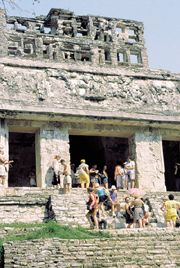
The Temple of Inscriptions is the tallest and most prominent of Palenque’s buildings. The tall roof comb that crowned it is long gone. The inscriptions in Mayan hieroglyphs on the interior rear wall are the reason for its name, dedicating the temple in 692 A.D. to King Pakal. Ascend the 69 steps to the top for access to his tomb. This pyramid served as a crypt for a revered leader as well as a temple base.The Group of the Cross consists of four buildings dedicated to Pakal’s son, Chan-Balum: The Temple of the Sun, Temple 14, The Temple of the Cross and the Temple of the Foliated Cross.
The Palace, opposite the Temple of Inscriptions, is an unusual structure with a maze of courtyards and rooms occupying the space of one city block. It sits on a platform 10 meters high which has an interesting labyrinth of underground passageways and tunnels.
The nearby community of Santo Domingo de Palenque, is a small town that bulges at the seams with the influx of tourists interested in the ruins. Meals and accommodation are very adequate.
| |
| For Assistance Call: |
